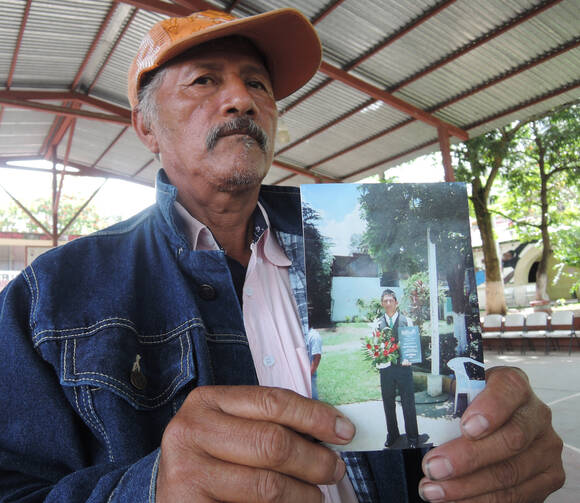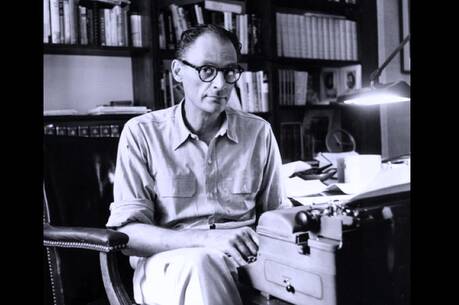Families of 43 students who "disappeared" in Guerrero state spend their time praying at the teacher training college the students attended.
They plead for intervention from Our Lady of Guadalupe and pray the rosary in front of a makeshift St. James shrine, adorned with flowers placed in plastic Pepsi and mayonnaise bottles and set up in a common area adorned with murals of Che Guevara and other revolutionaries.
They also worry and wonder about the whereabouts of the students, who were shot at by police in late September and subsequently were snatched from a bus -- all in an area where mass graves containing charred remains were found shortly thereafter.
"We're going crazy here thinking about this," said Margarito Ramirez, a corn and hibiscus farmer whose son, Carlos Ivan Ramirez Villarreal, is among the missing.
"We have faith and hope that God is all powerful, that these people will let our kids go," Ramirez added.
Faith has been in short supply in Mexico, where organized crime and drug cartel killings have claimed more than 70,000 lives and resulted in more than 30,000 people missing over the past eight years.
The Sept. 26 disappearance of so many students in Iguala has sparked international outrage and soul-searching among many Mexicans, though it took time for the horror to make headlines, which often screamed indignation louder abroad than at home. Stoking the indignation have been the accusations against Iguala police, who allegedly acted in cahoots with criminals; the local mayor has been accused of attacks on his enemies.
"We have to talk about forced disappearances and possible executions," said Mario Patron, deputy director of the Jesuit-run Miguel Agustin Pro Juarez Human Rights Center in Mexico City.
"The message to the society as a whole is powerful in that if it can happen to a group of students, it can happen to all of society," he said.
The apathetic initial reaction from society at large did not surprise Patron and others working with victims of violence, who often suffer the stigmatization and suspicions of somehow being involved in illegal activities or complicit in the crimes committed against them.
"This has been part of a federal strategy," Patron said, "to show that the big parts of the deaths in recent years are a consequence of battles between organized crime groups as if violence were not the responsibility of the state."
The abductions appear to run counter to claims by President Enrique Pena Nieto, who talks up structural reforms and seldom mentions crime, that illegal activities are on the decline and that there's a "Mexico at peace." It also follows accusations that soldiers summarily executed 22 individuals in the town of Tlatlaya. Three soldiers have been charged in the case.
"The term of Enrique Pena Nieto, which tried to sell a new face of Mexico to the world, ended with the massacre of Ayotzinapa," columnist Jorge Campos wrote on maspormas.com.
Campos referred to Ayotzinapa, site of the Raul Isidro Burgos normal school, which trains teachers to work in isolated and impoverished parts of Guerrero state. The state, south of Mexico City, contains municipalities with human development index scores on par with sub-Saharan Africa.
The students, who will work later in schools often lacking electricity and water, live at the college, which has a left-leaning bent and penchant for protests. The "disappeared" students attended the school.
"The education that they (Raul Isidro Burgos teachers) give them is somewhat critical. It's not an education that points them toward conformity," said Father Mario Campos, a priest in the impoverished La Montana region of Guerrero and founder of community police forces he says have curbed crime and corruption.
Budget cuts in recent years have promoted protests, which have often been carried out by students arriving on buses they've commandeered.
"They're looking to get ahead," Father Campos said. "The problem is that they have to protest. When there are mobilizations, it's because there are demands."
The Raul Isidro Burgos students went to Iguala Sept. 26 to collect funds for a trip to Mexico City in early October, but were stopped by municipal police. Three students were shot dead, while 43 were detained and disappeared.
Guerrero Attorney General Inaki Blanco told reporters Oct. 5 that two cartel hit men confessed to killing 17 of the students.
Since the late-September incident, Iguala Mayor Jose Abarca has been disowned by his own political party and is now a fugitive. Abarca's family has been tied to organized crime.
Protesters marched across Mexico Oct. 8, demanding the students be brought back alive and the case be solved, something Pena Nieto has promised will be done. Others in the marches called for an end to political collusion with organized crime.








